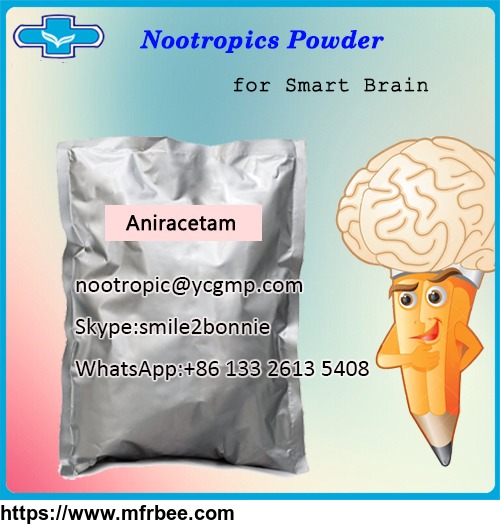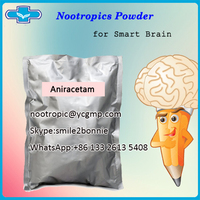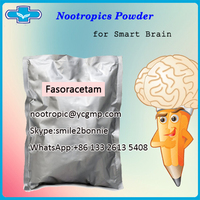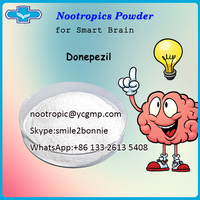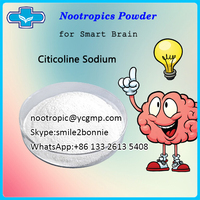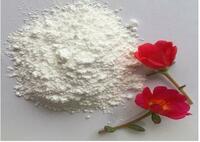Aniracetam Powder/nootropic@ycgmp.com
Product Name: Aniracetam
Alias: Draganon,Sarpul,Ampamet,Memodrin,Referan
CAS: 72432-10-1
MF: C12H13NO3
MW: 219.24
Purity: 99.45%
MP: 120.1~120.9℃
BP: 399.7°C at 760 mmHg
FP: 195.5°C
Density: 1.236g/cm3
Grade: Pharmaceutical Grade
Appearance: White Crystalline Powder
Aniracetam is a popular choice among nootropic users for its ability to enhance cognition while reducing anxiety and boosting mood. It's also moderately priced and has little side effects when
taken at recommended dosages. Aniracetam is chemically classed as a racetam, and like most racetams, it works to a large extent by modulating neurotransmitters.
Aniracetam, also known as N-anisoyl-2-pyrrolidinone, is an ampakine nootropic of the racetam chemical class purported to be considerably more potent than piracetam. It is lipid-soluble and has
possible cognition-enhancing effects. It has been tested in animals extensively, Alzheimer's patients, and temporarily impaired healthy subjects.
Description
Aniracetam, a cyclized derivative of γ-aminobutyric acid, can improve the brain function. It can selectively exert effect on central nervous system through penetration into blood-brain barrier. It
can activate the metabolism activity of brain cell and protect the nerve cells. This product can also promote the intelligence by affecting the glutamate receptor system.
Moreover, it improves skin's resistance to hypoxia, preventing the occurrence of malfunction of learning and memory caused by a variety of chemical substances, hypercapnia, scopolamine and
electrical shock. This product has no sedative or excitation effect. Animal experiments show that this product promotes the memory recovery in normal rats' learning process. It can fight against
hypoxia-induced memory recession and relieve the memory malfunction caused by certain reasons.
Aniracetam Benefits
As stated above, Aniracetam can have many off-label uses. It is considered a fairly safe and low toxicity substance to improve cognition and memory or reduce anxiety symptoms. Like other racetams,
it can have an added benefit of reducing free radicals and oxidative stress in the brain which can lead to degenerative diseases and neurological complications. It should not be used as a main line
of defence or treatment for degenerative diseases like Alzheimer's and Dementia but may have merit in reducing some of the symptoms associated. Below, are some of the common observed benefits of
Aniracetam. Results may vary.
Improved Memory
Increased Learning Ability
Improved Cognitive Processing
Heightened Reflexes
Heightened Perception
Reduced Anxiety
Reduced Depression
Stacking
Like most racetams, aniracetam works well on its own or in combination with other nootropics. Here are some common aniracetam stacks to consider.
Aniracetam and Choline Stack
Choline, an essential nutrient which we consume in our diet, is a precursor to the neurotransmitter acetylcholine which responsible for various brain functions such as memory. This process is
especially relevant when taking aniracetam since it works in part by stimulating the cholinergic system. Supplementing choline ensures that there is enough in your system to maximize aniracetam's
effects while mitigating the potential common side effects that may result in the lack of acetylcholine in the brain such as headaches.
The PAO Stack
The PAO stack, an acronym for piracetam, aniracetam, and oxiracetam, is a classic stack that involves combining these three popular nootropics. Stacking aniracetam with piracetam and oxiracetam
strengthens the perceived effects of all the components in the stack and could potentially extend the period of which the benefits are experienced. Including piracetam may also intensify
aniracetam's anti-depressive and anti-anxiety properties.
Aniracetam Dosage
While individual requirements vary, a dosage of 750-1500 mg is typically accepted as both safe and effective, though doses of up to 3000 mg daily have been documented as well-tolerated. It is wise
to start with the minimum effective dose and gradually increase as necessary. One human study involving individuals with senile cognitive disorders reported benefits over placebo at 1500 mg/day.
Because of its relatively brief half-life of one to three hours, dosage may have to be repeated at intervals to maintain effects. Like most nootropics in the racetam family, the effects of
aniracetam may diminish if too much is present in the system, so dosage should be monitored closely.
Side Effects
When taken at recommended dosages, aniracetam produces very few documented side effects, and those that are reported are both minor and temporary. The most frequently reported side effects of
aniracetam are headaches and mild nausea, both of which can often be successfully addressed by the addition of a choline source.
High doses of aniracetam can result in a feeling of excessive nervousness, digestive discomfort, or both. If either of these effects occurs, try reducing dosage. Some users report a loss of
inhibition when taking aniracetam; while not necessarily an unwelcome side effect, a sudden feeling of loss of inhibition could be surprising and perhaps unsettling (especially in retrospect).
